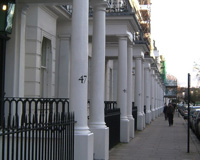London’s Royal Borough of Kensington & Chelsea has lost a High Court case over the restrictions that should be applied to basement developments.
Lawyers for the borough were seeking a judgment clarifying whether a rule limiting permitted development on home extensions “where the enlarged part of the dwellinghouse would have more than one storey” applies when a new floor is added below an existing house.
Kensington & Chelsea said it should. Lawyers for the secretary of state for communities and local government said it shouldn’t. Mrs Justice Patterson, the judge hearing the case, backed the secretary of state.
The hearing started today and had been scheduled to last for two days. However, Patterson J told lawyers part way though today’s hearing that she had enough information to come to a judgment.
The case relates to the way the Town and Country Planning (General Permitted Development) order 1995 is applied to the construction of basements under residential properties.
According to the rules, development isn’t permitted under class A if the “enlarged part” of the dwellinghouse would have more than one storey and either extends beyond the rear wall of the original dwellinghouse by more than three metres or is within seven metres of any boundary opposite the real wall of the dwellinghouse.
This case concerns developments where the proposed basement mirrors the footprint of the house, and, as large back gardens are uncommon in the area, brings the basement to within seven metres of a rear boundary.
Kensington argued that “the construction of a basement comprises of the addition of a storey to the dwellinghouse,” and therefore means that the “enlarged part” of the house would have more than one storey.
Lawyers for the secretary of state said that Kensington’s argument misinterprets what is meant by “enlarged part.” They said that the “enlarged part” of the house refers to the proposed basement and not the house as a whole. The proposed basement development has no more than one story so isn’t caught by the rules.
Patterson J said that Kensington’s interpretation was “artificial.”
The question being asked is “would the enlargement of the original dwellinghouse be more than one storey? The answer is ‘no,’” she said. “What was to be constructed was a single storey basement.”
The Royal Borough of Kensington & Chelsea v The Secretary of State for Communities and Local Government, Planning Court (Patterson J) 17 June 2015.
Mark Lowe QC and Jack Parker for the claimant.
Philip Coppel QC and Ryan Kohli for the defendant.









